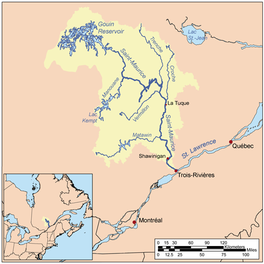|
Du Mâle Lake (Gouin Reservoir)
The Male Lake is a freshwater body located in the western part of the Gouin Reservoir, in the territory of the town of La Tuque, in the administrative region of the Mauricie, in the province of Quebec, in Canada. This lake extends mainly in the cantons of Lacasse (northern part of the lake), Toussaint (north-east), Hanotaux (west), Crémazie (center west), Lemay (center east), Poisson (South-West) and Evanturel (South-Central). Recreotourism activities are the main economic activity of the sector. Forestry comes second. Recreational boating is particularly popular on this water, especially for sport fishing. The hydrographic slope of the "Du Mâle Lake" is served on the side:
The surface of Male Lake is usually frozen from mid-November to the end of April, however, safe ice circulation is generally from early December to late March. Water management at the Gouin Dam can lead to significant variations in the water level, particularly at the end of the winter when the water is lowered. GeographyBefore the completion of the construction of the La Loutre Dam in 1916, creating the Gouin Reservoir, the "Du Mâle Lake" was close to 30 kilometres (19 mi) in length and was the main body of water of the head of the Saint-Maurice River. After the second raising of the waters in 1946 with the development of the Gouin Dam, the "Du Mâle Lake" took its present form, forming numerous bays through marshy banks. This body of water has several bays that once formed neighboring lakes: Plamondon Bay (Gouin Reservoir) in the West, Mattawa Bay in the Southwest, Saraana Bay in the South and Aiapew Bay to the Northeast.
The main hydrographic slopes near the Male Lake are:
With a length of 36.6 kilometres (22.7 mi), from the mouth of Mattawa Bay, the Male Lake stretches northeast to Aiapew Bay in the northern part of Bourgeois Lake. Deformed in nature, the "Du Mâle Lake" has several dozens of islands, peninsulas and bays. The "Du Mâle Lake" narrows to only 1.0 kilometre (0.62 mi) at its center, forming the Kaopatinak Pass (length: 2.1 kilometres (1.3 mi)), because of a peninsula advancing on 5.7 kilometres (3.5 mi) towards the North-West and opposite a peninsula advancing on 4.1 kilometres (2.5 mi) towards the South-East. Northeast part of the lake The northeastern part of the lake stretches over 16.4 kilometres (10.2 mi) by 9.4 kilometres (5.8 mi), forming several secondary bays, such Miller Lake (Gouin Reservoir). Its main tributaries are the Piponisiw River and the De la Rencontre Creek (coming from the North). Northeast of the lake, an archipelago delineates the "Du Mâle Lake" with the Bourgeois Lake. The largest of these islands has a length of 6.9 kilometres (4.3 mi) and a width of 2.9 kilometres (1.8 mi); it straddles the townships of Toussaint and Lemay. Delimited in its southern side by the "Bay of Eagles", this island is located at 6.0 kilometres (3.7 mi) west of the village center of Obedjiwan, Quebec. Southwest of Bourgeois Lake, Thibodeau Bay also extends behind this archipelago. Southwest part of the lake The southwestern part of the lake stretches on 10.7 kilometres (6.6 mi) by 12.4 kilometres (7.7 mi), until the Kaopatinak Pass which is located at the center of the lake. This southwestern part includes the following main bays: Saraana, Mattawa Bay, Adolphe-Poisson, Hanotaux and Plamondon. The largest island of this part of the lake has a length of 8.0 kilometres (5.0 mi); it delineates the Matci Rock Bay, located on the east side of the southeastern part of the lake. The mouth of "Du Mâle Lake" is located northeast of the lake, at:
From the mouth of "Du Mâle Lake", the current flows over 89.5 kilometres (55.6 mi) to Gouin Dam, according to the following segments:
ToponymyFormerly, this body of water was designated in the Innu language "Ayamba Sacahigan", as noted in 1871 by the surveyor John Bignell, meaning "lake to the male". In 1980, a survey carried out in Attikamek territory lists the name "Aiapew Sakahikan", which translates as "male moose lake". The form "Acohonan", meaning "lake where we can cross" is also known to Attikameks. Officially, until 1945, this body of water was designated "Grand lac du Mâle".[2] The southern part of "Du Mâle Lake" includes a bay designated "Petit lac du Mâle" (English: "Little Male Lake") which includes the "Sandbank". This bay is located on the north shore between Plamondon Bay (Gouin Reservoir) and Kaopatinak Pass. This toponymic designation dates from the early 1980s. The toponym "Lac du Mâle" was formalized on December 18, 1986, by the Commission de toponymie du Québec.[3] Notes and references
See also
|
||||||||||||||||||||||||||
Portal di Ensiklopedia Dunia

